Equipment: Paintbrushes
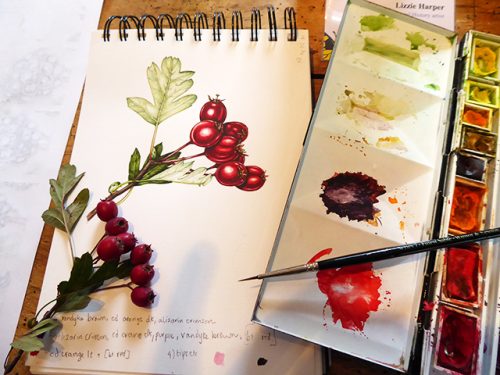
Equipment: Paintbrushes is another in the series about what tools I use when I illustrate; so feel free to check out my earlier blogs on what watercolour paper to use, the guest blog on waterproof inks, watercolour paints, pencils and erasers, and another on what science stuff you might need.
Paintbrushes
As with all of these posts, it’s vital to stress that what equipment one uses is a very personal choice, and we often finesse our techniques according to the equipment and brands we use and like most. I’d love people to add their own favourites in the “Comments” section at the end of this blog, then the post would serve as a much more balanced resource for artists starting out, or for established practitioners looking for new ideas.
There’s also a section where I test several synthetic sable brushes, looking for an alternative to real sable ones. There’s a film of these trials on Youtube.
Since writing this I’ve done a second comparison blog which you can find here, and associated film here.
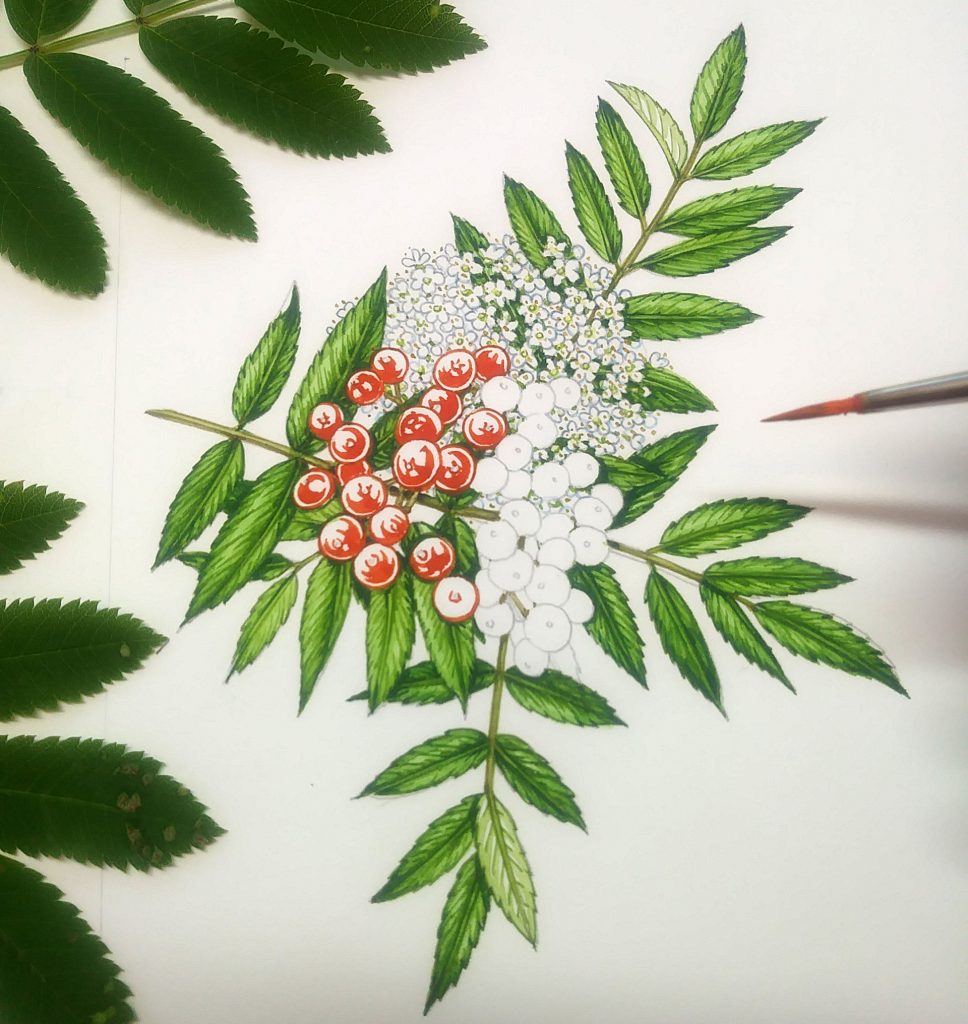
Illustrating Rowan Sorbus aucuparia
Paintbrushes
I absolutely love, and have always used, Winsor and Newton series 7 sable paintbrushes. They’re expensive, yes, but I’m yet to find another brush that comes close to their quality. They hold plenty of paint. Their points stay true and tiny. They rarely shed, and when they do it’s a discrete one hair at a time. The paint on the handle doesn’t peel or crack off and fall onto whatever you’re doing. The metal part (the ferrule) never rusts.
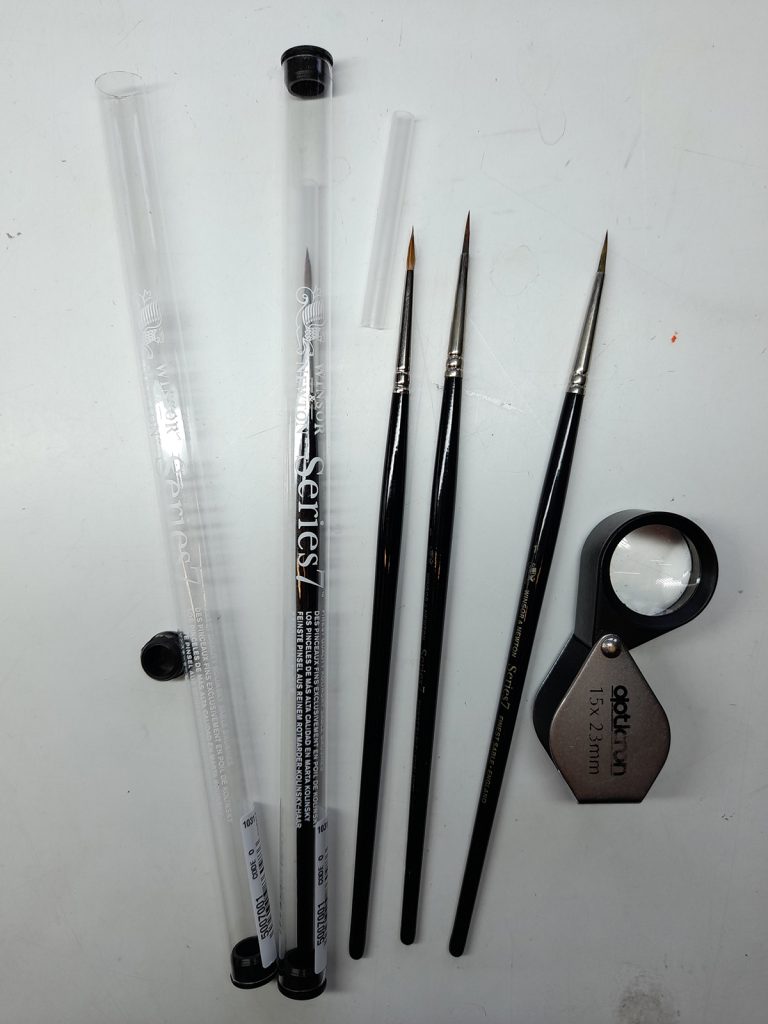
Series 7 brushes with another vital tool of the trade, a hand lens
You can get them in “Miniature Painting” and “Round”; I’ve tried both and tend to go for the round ones, simply because that’s what I’m used to.
Size of paintbrush
Size-wise, I do almost all my illustrating with a number 1. I have a stash of about 10 ready to go at any given time, and work through something like one every 6 weeks. As I say, they don’t shed much, but inevitably they do suffer from the wear and tear of daily hard use. There’s no need to dispose of these worn brushes, just use them for more detailed work. After all, in effect they’ve turned into a smaller size 0!
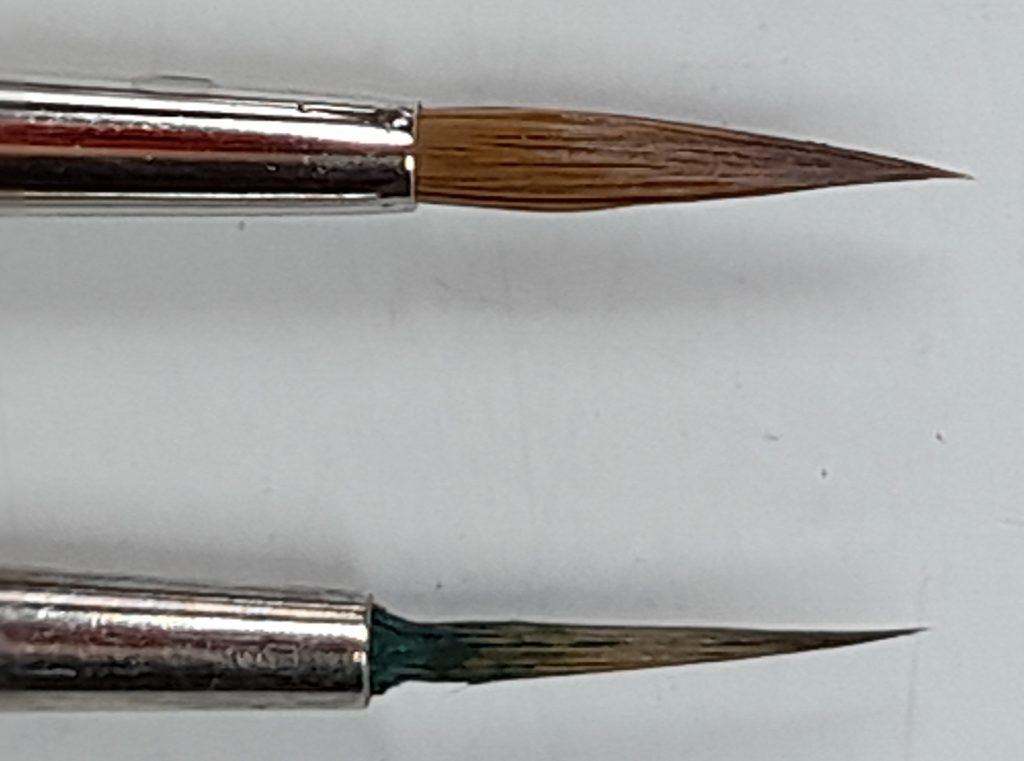
Comparison of two Number 1 paintbrushes; above is a new one, below is one I’ve been using for 4 weeks
I use the larger number 2 size for looser washes, and have a number 4 and a number 6 for when I do big washy backgrounds (in my landscapes). These bigger brushes still have good points, and can hold loads of paint, so doing a big area of sky, forest, grass, or fields is possible.
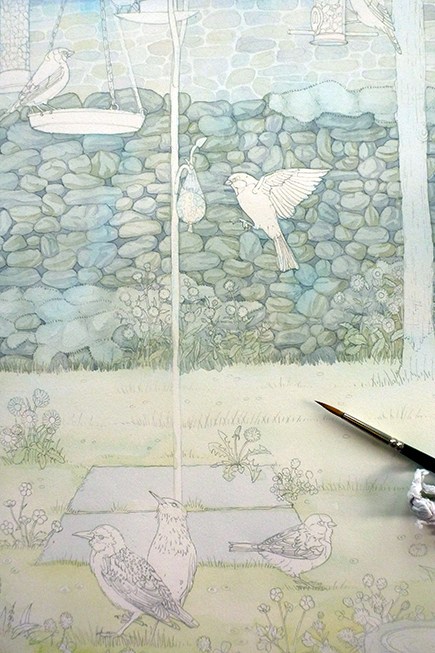
Using a number 4 brush for background washes
As well as my worn and thinned number 1 brushes, I also use the tiny 000 and 00 sizes for painting in almost invisible hairs, and details within flowers. The tips of these are the ones that make people think you’re almost mad to use them, but they’re vital when getting the minutae down. I used 00 brushes a lot when illustrating a series of mosses.
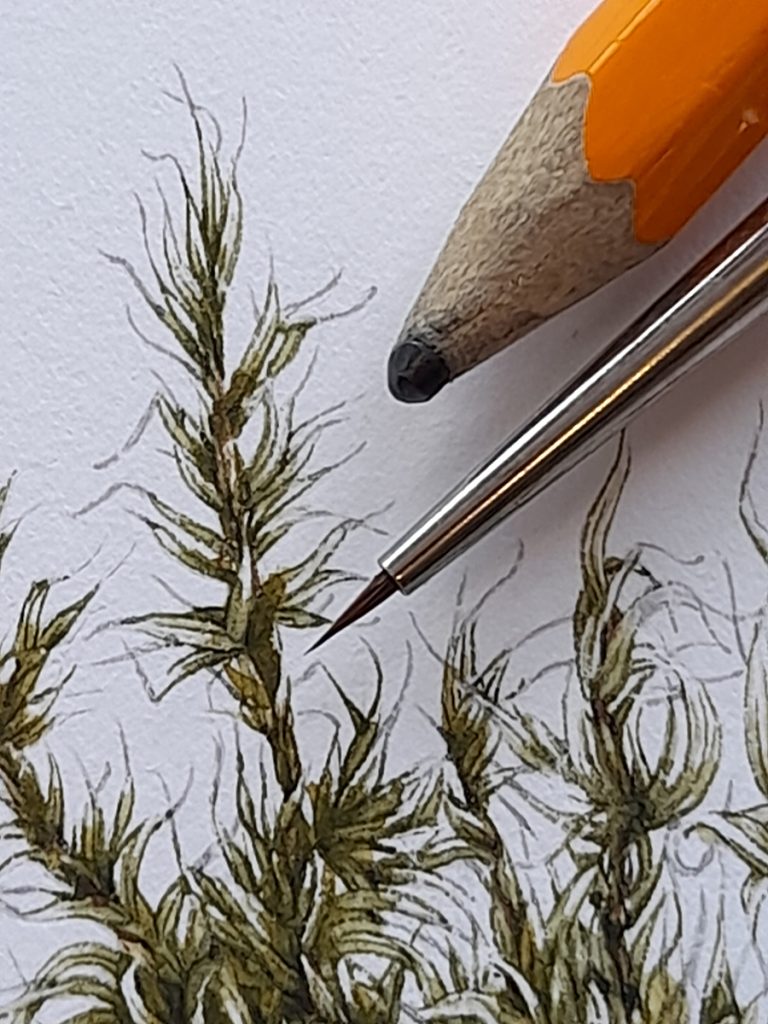
A 00 size brush alongside a pencil for scale, and illustration of Woolly fringe moss Racomitrium lanuginosum
Other brands
I know there are other brush brands out there, some of which I’ve tried and some which I haven’t. A lot of other botanical illustrators really like Rosemary brushes – they didn’t work brilliantly for me, but they’re probably worth trying. They certainly are good quality, and are significantly cheaper than Series 7.
I once had a comment questioning the ethics of using sable brushes, and it is true that these brushes are made of sable hair, a species similar to a pine marten. As a vegetarian committed to all sorts of ecological and environmental causes, I would certainly appreciate having a top-quality, animal-free alternative brush, so if anyone knows of one, please leave a comment.
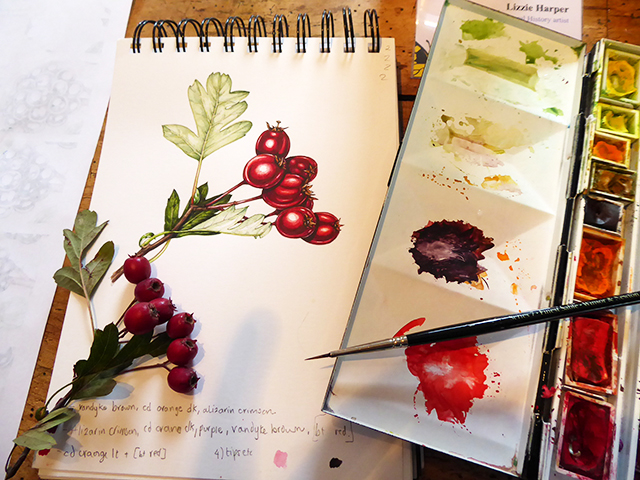
Completed sketchbook study of hawthorn berries Craetegus monogyna, completed with a well-worn Series 7 no. 1 brush
Synthetic alternatives to Sable
Having written this blog, and following very useful feedback from other illustrators, I decided to try out a handful of high quality synthetic sable brushes. Not only are these more ethical for a vegetarian such as myself, but they’re also a darned site cheaper! I filmed these trials, here’s a link.
All the brushes were round number 1 size.
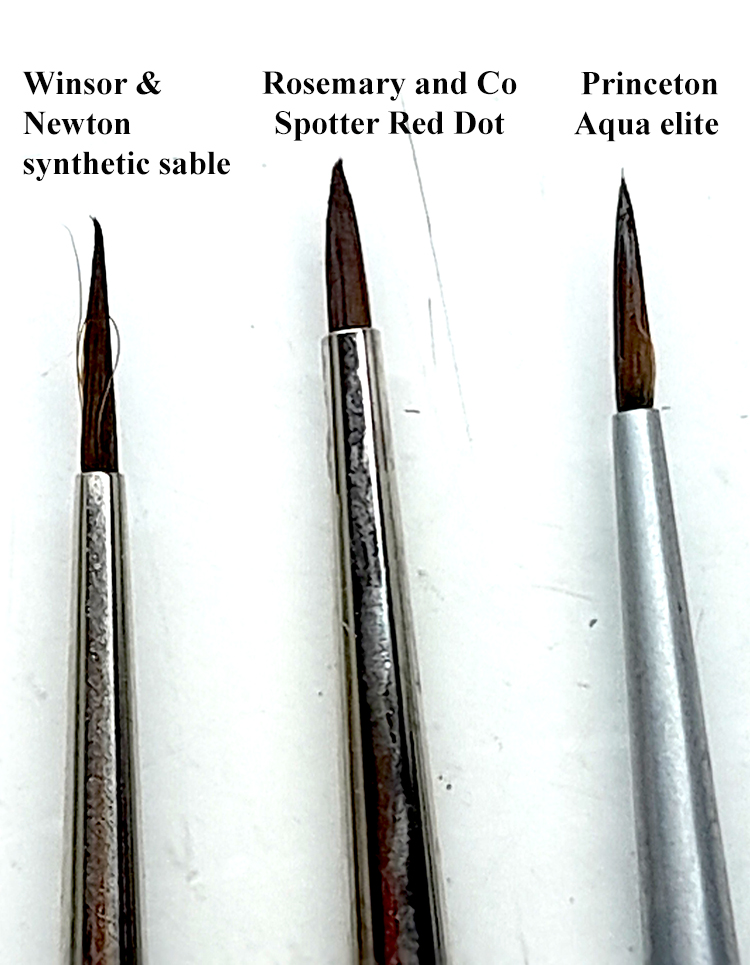
Comparing the points of the three new synthetic watercolour brushes.
The three brands I compared were Winsor & Newton synthetic sable, Rosemary and Co. Spotter Red Dot, and Princeton Aqua elite. None were appalling, and one came close to equalling my beloved Series 7 brushes.
Synthetics: Winsor & Newton synthetic sable
I was surprised that this brush looked scruffy on removal from its’ tubing. Working with it, although it did have a point and did hold paint, the brush was too long. This meant I couldn’t achieve the tight control I require. The stray hairs didn’t help sell the brush to me. The handle was comfortable. Price wise, I found them selling at £5.80 each, or on sale for £4.06.
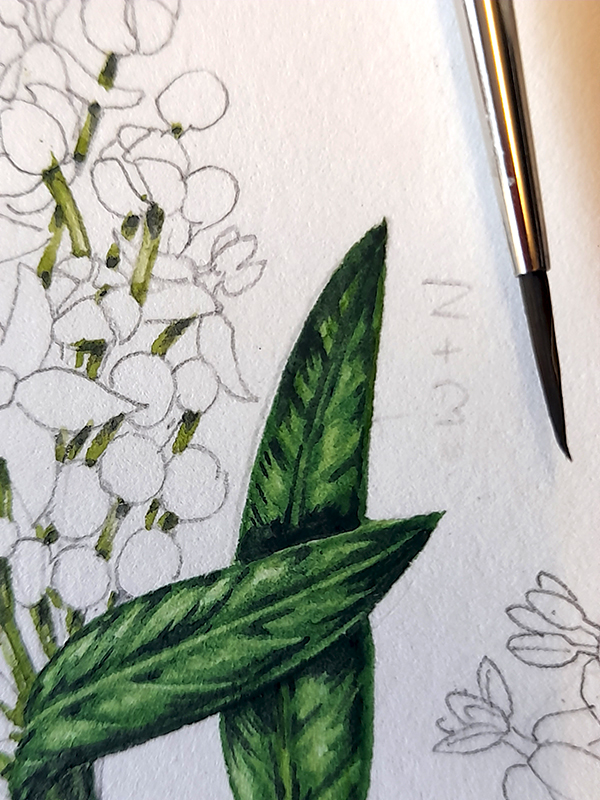
Close up of the Winsor & Newton synthetic sable brush, with the leaves I painted using it
The very tip of the brush also had a noticeable “hook” which made it hard to get that sharp point. With the Series 7 brushes, if I roll them into a tip in the wet paint, the point is exquisite. With this dowdier cousin, I couldn’t get the frighteningly crisp point I look for.
Synthetics: Rosemary and Co. Spotter Red Dot
This brush was definitely my favourite of the synthetics I trialled. The brush shape didn’t appeal at first – the point of the brush looks short and dumpy. However, the point was very sharp, and it worked well in wet and dry paint. it was only when using the brush with extremely wet and pale washes that the point held less well.
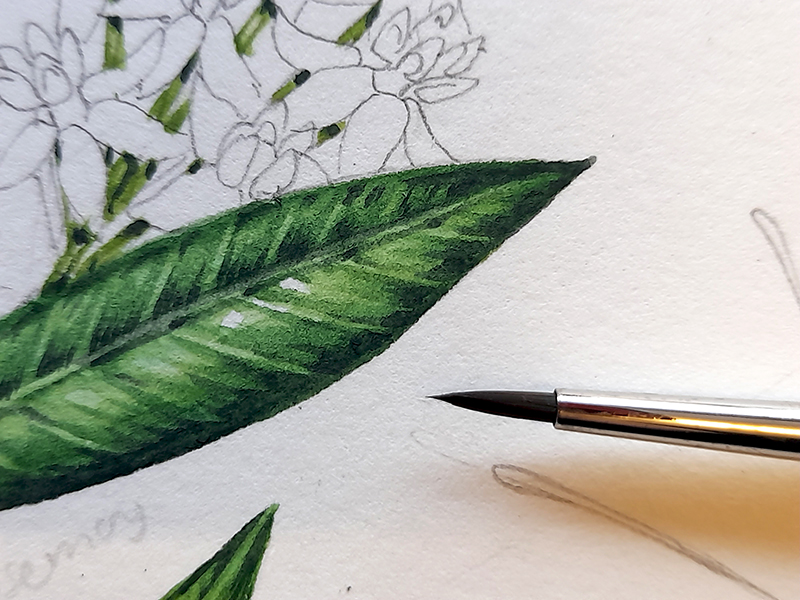
Close up of the Rosemary and Co Red Dot synthetic sable brush, with the leaves I painted using it
I was really impressed by this brush, and at a price point of £3.40 each they would be excellent alternatives to a Series 7 brush for those on a budget.
Were I to commit to getting sable out of my life, this is certainly a contender for a replacement.
Synthetics: Princeton Aqua elite
The Princeton Aqua elite had a decent point. Again, it was absolutely serviceable. However, the brush felt like it had lateral compression. It felt flattened, with the associated slight splaying of the point that a flattening brings. I almost felt that the nib was too long.
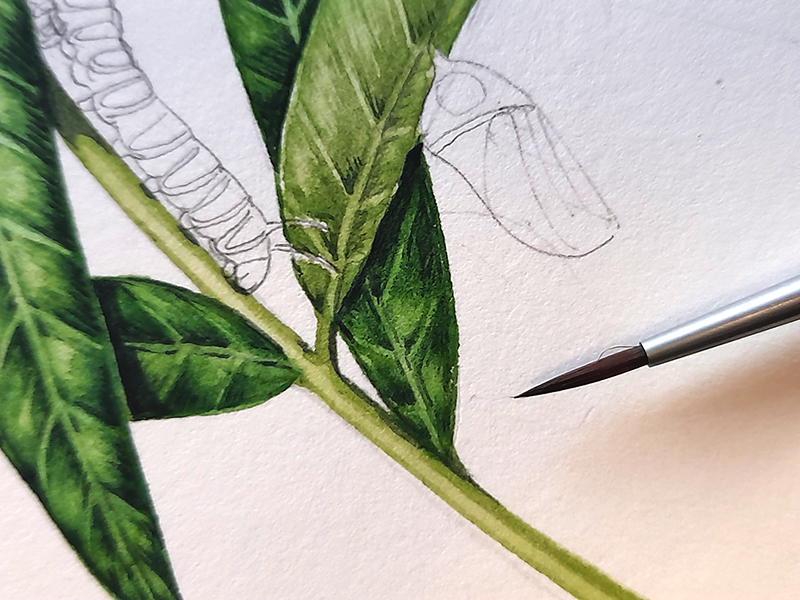
Close up of the Princeton Aqua elite synthetic sable brush, with the leaves I painted using it
This feeling of the brush being too long also made me feel uncomfortable using it. I had to focus and concentrate to ensure I got the crisp lines I was after. I felt slightly less control that I wanted.
However, as with all things, this could be because I’m used to a shorter-shaped brush. These things are so very personal.
The price for this brush is £5.80; exactly the same as the Winsor & Newton synthetic sable.
Synthetics: Conclusion
Having tried all three brushes, I attempted finishing the test illustration with them. It shows how very set in my ways I am that within half an hour I had reverted to the Series 7 brush.
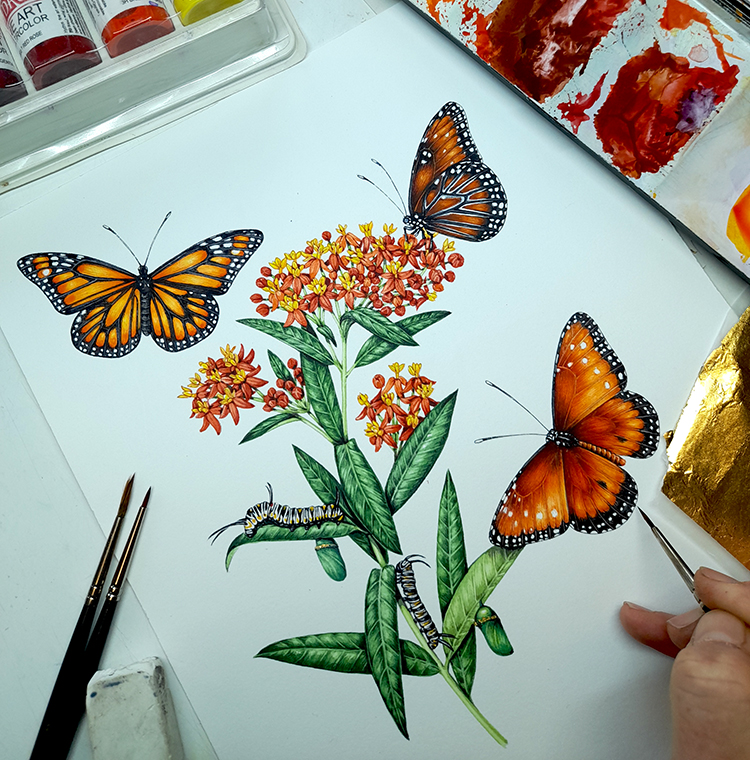
Completed illustration (initially used as a synthetics brush comparison test piece)
These synthetic alternatives are all good. the Rosemary & Co. brush is excellent. If I were to commit to sable-free illustration, I’d certainly be investing in some of these Red dot brushes.
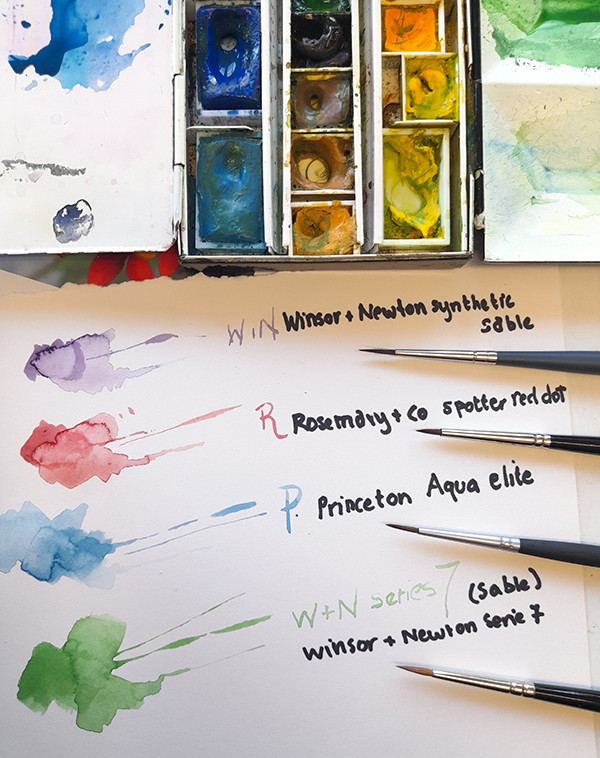
Comparison of synthetics and Series 7
Price wise, for anyone on a budget I will heartily reccommend these brushes. One of my Series 7 brushes costs up to three times the price of one of these – a cool £17.10 cost price (2021 prices). They can be got on sale for £11, but even at discount that’s a much bigger outlay than for the £3.80 Rosemary one.
For much more detail on this comparison, do check out my Youtube film.
Zen Art Fineline Minature brushes: Trying out a freebie
I was recently sent a set of ZenART fineline minature paintbrushes to try and review by the manafacturers. Obviously, the company sent them to me for free, looking for a good review, and some decent social media feedback. I’m a little cynical, so I tried them without a great deal of conviction. It’s important to have full disclosure about these things, I think…

They came in a cardboard box, and inside is a lovely canvas carrying thingy, all bound in red ribbon. There’s a great assortment; riggers, filberts, and angled brush, and several round ones. I only use round ones, so those are the ones I can speak for.
I’m surprised to say they were really good, and potentially a welcome alternative to my beloved Winsor & Newton series 7 brushes. They held their points, didn’t splay, had decent wells to hold paint, and produced consistent tiny lines. The number 2 was good for pale top washes, holding lots of paint and having the required sharp point. Accuracy was good with the number 1 and the 5/0.
They are also synthetic, which is an excellent thing in terms of my feelings about using animal hair to make brushes.
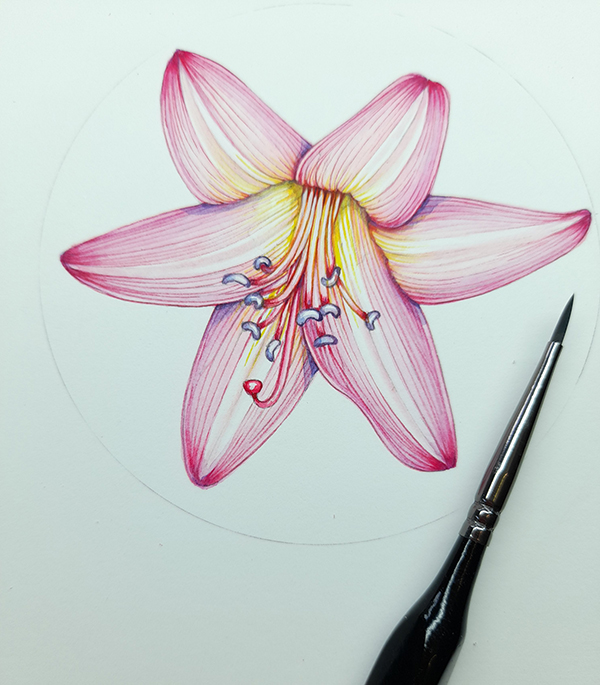
However, by the third of fourth day of use, the tips had become slightly blunted and weren’t holding the crisp point I require. In every other respect they remained really good; they didn’t shed any hairs, rust, nor discolour. The paint on the handle remained in place and didn’t peel or crack. For me, the loss of tip is a deal breaker. I would suggest folks who don’t need such a precision-perfect tip could do a lot worse than go for these (very reasonably priced) brushes, but if you need a very crisp point then for me, they haven’t made the cut. But definitely worth a try.#
Synthetic brushes: A hint to help fix hooked tips
This tip has come in from Rebecca, who left this suggestion in the comments section. Many thanks for sharing it with us. “Hooks that develop on synthetic bristles can often be remedied by dipping the bristles about half way into a cup of water taken off the boil. Take care not to get the ferrule or upper bristles wet with water this hot or it may affect the glue. The timing varies from 10-30 seconds based on the brand and size. Gently reshape the tip on your thumbnail after heating. While I don’t expect that is an annoyance one would want to deal with during a long painting session, it will at least restore the brush to a usable condition for lighter tasks.”
Conclusion
So there you are. The easiest of all these equipment blogs. What paintbrush do I use? A Winsor and Newton Series 7, size 1. And no, they don’t pay me or give me free brushes to say this (however, if someone working for the company is out there and has a whole load of brushes they want to get rid of….?)
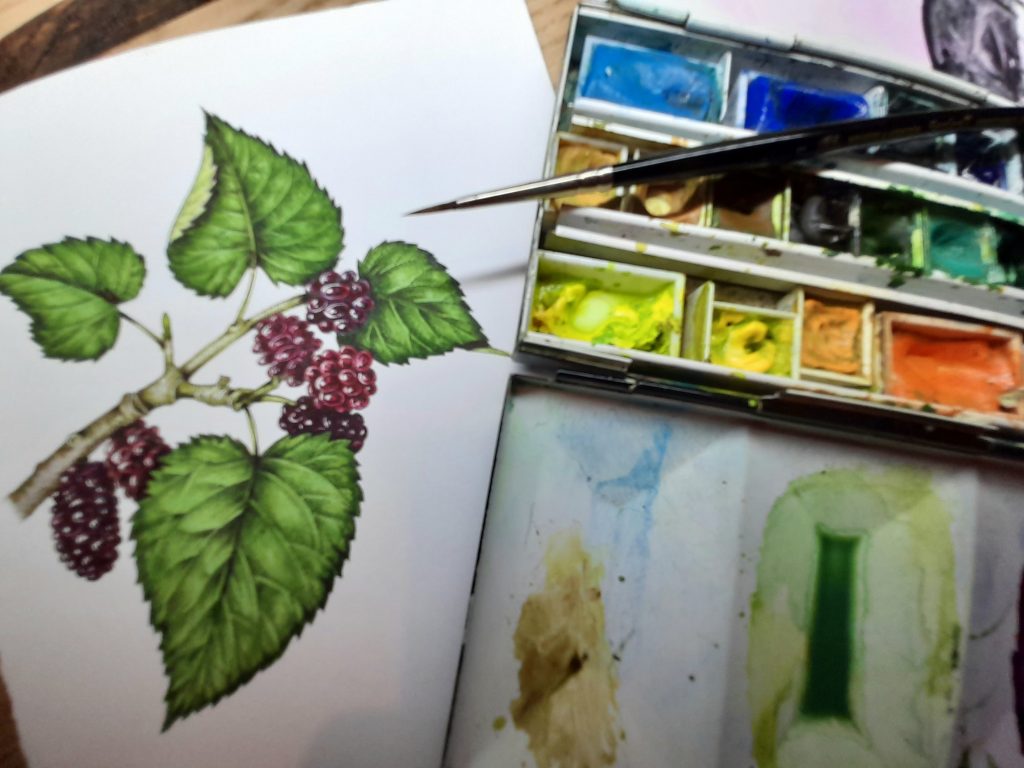
Mulberry Morus nigra with paintbox and Series 7 brush
Other alternatives are the Rosemary brushes (which some people adore) and the Zen art minature fineliner brushes reviewed above, both of which are a lot cheaper that W&N. But thus far I’m still to find a real potential replacement for my Series 7s.
You can order these brushes direct from Winsor and Newton, or from your local art shop. If that’s not possible, look for good online art suppliers like Jackson’s, Cass Art, London Graphics Centre, or Ken Bromley. In the US I believe Dick Blick to be a good art store.


Thank you. Cannot beat W&N brushes. Worth doing without Starbucks for.
Have you tried W&N watercolor pencils?
Ah Beth, you agree about the brushes. yes, I know the price is eye-watering, but the brushes are mouth-watering, so there we go! No, Ive not tried the pencils yet. Any good?
Haven’t tried them yet. Have signed up for a local workshop on them in Nov. Will let you know.
Your blogs are my go to when I need reassurance that beautiful art for illustration is still being made.
Thank you.
Thanks, Beth. That’s a really lovely thing to say. And if you do try the pencils, let me know how it goes?
X Lizzie
Hi Lizzie,
I love working with the Rosemary spotters, series 323. They are pure Salinsky sable. I also have a few W& N nr 7, but I prefer the spotters. Is it not silly? ( my cat seems to get to chew on my brushes, when he gets the chance, grr) However Rosemary has now come up with a Red Dot serie, pure synthetic. I have yet to try them, having send over just a few brushes to Hungary just to try, would be very silly. I have to wait until I need more then a few. But for you living in England it might be worth a try.
But it is true, working with the materials one is used to feels best.
Have a great day,
Ineke
Ineke, perhaps this is exactly the information I need. I shall buy 1 x red dot and 1 x 323 sable Rosemary spotter and give them a go. There are now three brushes I need to try; Princeton Snap and W&N synthetic too. Better get online and start spending! If I find any that are amazing Ill update the blog, and leave a comment here. Thanks so mcuh for your time, and suggestion! Ill let you know how the synthetic Rosemary brush goes once I order it. x
Thank you, it is very difficult to find quality paper, brushes here. I can not find your Fluid 100 anywhere.
if you really like the red dots. Let me know. Saves me money for trying out. I have a lot of brushes. But not many I really like. What to do with a surplus of brushes, one does not use?
I am now working on my first ever bird, I used a proportional divider for drawing it. A nuthatch. The 2 nd one I saw here, cat brought this one in, thankfully still alive. So I was able to let it go free,with a warning to be extra careful, after having a good look at him.
I’e ordered red dot brushes thanks to you, so I’m excited to try them. Old paintbrushes eh? I give them to my kids. But there should be a better thing to do with them! How wonderful to be illustrating a nuthatch, and (despite the trauma) to be able to get so close to one. They’re stunning birds, aren’t they?
If you email me your postal address Id be happy to pop a couple of sheets of Fluid 100 in the post to you, no charge? I know you can get in from jacksons art supplies here in the UK, but of course they may not ship overseas… My email is info@lizzieharper.co.uk
Thanks
Lizzie
Good evening Lizzie, I am in awe of your work and the variety of it. I have even tried following from You Tube your methods but I cannot get the intensity and density of colour you get with W and N watercolours. Is there an existing article or video showing your balance of water to pigment?
Absolutely stunning work.
Regards Peter
Hi Peter
Oh you are good for my ego, your comments have gone straight to my head. Thankyou. No, there’s not a film of me mixing my colours, but perhaps I should do one? I do bulk up the intensity of some colours by adding a drop on Dr PH Martins Hydrous ink, but this certainly doesn’t get added to every colour mix. The paint goes one quite dry, the consistency of single cream I’d say. But maybe I should upload some colour mixing snippets – its not a bad idea for a quick film. Thanks.
Sorry not to be more use than this!
Yours
Lizzie
That is fine Lizzie. You are worth every penny of the ego.
Thank you from a newbie to this art.
Regards
Peter
Hi Lizzie,
The most pointy synthetics are the Loew-Cornell 7020 Ultra Rounds that are soo pointy that you can paint with a number 4 or 6 what you usually paint with your number 1 W&N sable.
I have three of them in different sizes that they were sent to me as a gift from USA. Mine are the number 6, 10 and 14.
Check the photo to see how pointy these brushes are. The thicker one is a number 6 Loew Cornell and the thinner one is the W&N Series 7 no 1 ( your favorite).
https://ibb.co/tb9wRd3
I made also some brushstrokes with both the LC and the W&N no 1 along with a line from a 0,5 mechanical pencil in order to get an idea of the lines that you can produce with the no. 6. They are same thin as those of the W&N no 1 but the brush lines are more saturated because the LC brush holds more paint.
https://ibb.co/sRY1J4F
And below are all my Loew Cornells along with the W&N one for comparison.
https://ibb.co/vmJN0Xw
Unfortunately I’ve just read that they are going to be discontinued,but you can still find them on some stores. So if you are interested to try them get some as long as they are available. I found them on the store below and they have the number 2 and 4 as well, that I assume that must be even more pointy.
https://gregdorrance.com/product-category/artist-materials/artist-brushes-lettering-quills-and-faux-tools/loew-cornell/7020-ultra-round-series/
If you take care of these brushes and you keep them with their protective plastic tubes on, they will last for very long. I have mine for almost two years now and I use them continuously and they are still in perfect condition.
I don’t know why Loew Cornell decided to discontinue one of its best brushes. 🙁
Bless you Marialena! Trust you to have something really new and interesting to add, thank you! What an interesting comment, and thanks for the links. Id never heard of the Loew Cornells, and you’re the first to mention them as alternatives to sable. I appreciate it. What a shame they’re discontinuing them! I do wish manafacturers would stick with their products, suddenly losing a trusted brand can be inconvenient, and sometimes downright distressing. They do look like their tips are a rival to W&N which is something I never thought I’d say about a synthetic sable. What a pity. But yes, I’ll keep an eye out for them and see if I can lay my hands on some old stock before it evaporates! Thanks again Marialena, you’re wonderfully reliable with your equipment information, and I really appreciate it.
Thank you for your thoughtful review. Hooks that develop on synthetic bristles can often be remedied by dipping the bristles about half way into a cup of water taken off the boil. Take care not to get the ferrule or upper bristles wet with water this hot or it may affect the glue. The timing varies from 10-30 seconds based on the brand and size. Gently reshape the tip on your thumbnail after heating. While I don’t expect that is an annoyance one would want to deal with during a long painting session, it will at least restore the brush to a usable condition for lighter tasks.
Rebecca – what a brilliant and helpful comment! I’m going to add that suggestion to the blog right now. I really appreciate you taking time to share this. x
Hi Lizzie, I thought I’d drop in to tell you my long long hunt for brushes, after many Ellen Crimi-Trent videos I’ve tried Princeton Neptune brushes, I’m so pleased with them. The one stunning difference is how long and even on handmade rough paper it can keep the edge tight and smooth.
It’s the best. For minature brushes I use “Artmaster Pearl series 11 ” they are so cheap but keep a lovely point. Don’t be thinking they are the Proarte Masterstroke brushes, the Artmaster have a far better point. I have a physical disability, finding brushes has been an epic journey, and I’ve tried loads of makes, I’ve a few sable ones, but would prefer not to have to use sable, and having found the Princeton Neptune I’m sorted. I bet they get discontinued now I’ve dated to tell someone!
Hiya, this is so helpful! Id not heard of the Artmaster Pearl series 11 before, Ill add them to the list to try. You’re not the first to recommend the Princeton Neptune brushes. Id ordered some in but need to give them another try. Thanks so much, and fingers crossed nothing gets discontinued!
Hi Lizzie … just wondered … did you do a review of the Rosemary & Co Red Dot spotters? I’m trying to find a synthetic brush/spotter for botanical work which has a short tip and maintains a good point (maybe a size 0 or 1?)
Kind regards, Susana, Tasmania
Hi Susana
I did indeed review the Rosemary & Co Red dot spotters. They came out quite well, but not as well as my trusty series 7s. Here’s the link to the blog: https://lizzieharper.co.uk/2021/09/equipment-paintbrushes/ and youll find a link to the youtube film review there too. Im still questing, but I do thing Rosemary and Co brushes are an avenue well worth researching furhter.
Good evening Lizzie, I am in awe of your work and the variety of it. I have even tried following from You Tube your methods but I cannot get the intensity and density of colour you get with W and N watercolours. Is there an existing article or video showing your balance of water to pigment?
Hiya Bayu. Many thanks for this (and for the flattery!) That’s a good question. No, I don’t there is is one specifically. I know I use the paint really thick, especially for the first layers when I’m putting down midtones and sorting out the lights and darks. So the consistency is something like thick cream, and stuffed full of pigment. I apply it pretty dry too, some people have said I use my paint more like gouache or a dry brush technique. SO have a go at using it much thicker than you would for traditional watercolour. You lose some of the ethereal quality of the paint, and some of that lovely effect on the sharp edges, but you do get a kick of colour.
I finally ordered some Rosemary and Co. brushes! Pricey from England -> US, but I’m hoping the sizes I chose are what I need… and the brush handle size, eeks. I went with the shorter one, seems like more control… regardless, thank you for recommending these!
Hi Catherine
Exciting! Let me know how you get on. There are new brushes coming out all the time. I need to make a follow up film and blog, there’s lots more on the market than when I did my research. But the Rosemary series do seem to be universally approved of. Hope they work for you, too. X
Great post! Watercolor brushes are truly a painter’s essential tool, and your blog does a fantastic job of highlighting their importance. Have you seen these models https://www.montmarte.com.au/collections/watercolour-brushes ?
Hi Holly, I hadnt seen that brand, but am glad to know of them. Thankyou.
Have a W/N series 7 size 1 that has held its point since 1982. Do like Raphael 8408’s and ordered some new ones to replace some old ones I have and felt lucky to have found them. A favorite is a pair of Isabey 6227z size 4’s which are small in size due to Isabey putting a lot of hair into the feral (about the size of a Raphael 8404 size 2). They have great spring for this reason and needle sharp points. Hard to find the Raphael pointed series 8408’s since Covid and the Isabey 6227z, which were once common, are no longer made, like so many of my large and huge size kolinsky brushes. However, the W/N series 7 brushes that you use and often recommend are still available many places.